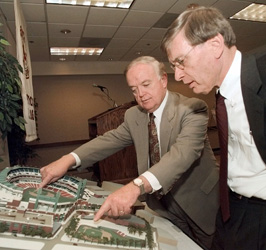Viewed strictly through the prism of 1999, it’s shocking that Fenway Park not only is still standing, but restored with more than $285 million of new renovations.
The spring of that year, then-Boston Red Sox Chief Executive John Harrington said “it would be easier to straighten the Leaning Tower of Pisa” than it would be to save Fenway.
Harrington in many ways was codifying a conventional wisdom quickly rippling not only through Boston, but all of baseball. The game then was fully in the midst of a stadium development boom sparked in large part by Baltimore’s Camden Yards, with a spate of new facilities coming online blending old-school architecture and design as well as, crucially, modern amenities.
 |
In this 1999 photo, former Red Sox CEO John Harrington (left) shows MLB Commissioner Bud Selig a model of a ballpark he proposed to build adjacent to the existing facility.
Photo by: AP Images |
Fenway, meanwhile, at that point was simply old and getting left behind. While structurally sound, the ballpark throughout the 1990s was visibly deteriorating amid peeling paint, broken seats, poor drainage, outdated technology and a host of other issues. Harrington, among others, dismissed a substantive rehabilitation of the existing facility as simply too cost prohibitive and disruptive to ballpark operations during the baseball season.
“The cost-benefit analysis at that point was certainly in favor of a new ballpark, modeled directly after Fenway,” said Dick Bresciani, Red Sox vice president emeritus and historian and formerly a longtime public relations executive for the club.
The key question, however, was where to put it. Earlier in the 1990s, a less developed push by Boston-area leaders to replace Fenway began to focus on a downtown sports and entertainment complex that would contain new homes for the Red Sox and New England Patriots, and a new convention center. The Boston Convention & Exhibition Center now sits in that area, but the sports teams ultimately would not join it there.
| When will Fenway Park be replaced by a new stadium? |
| Never |
35% |
| More than 20 years from now |
29% |
| 11-20 years |
20% |
| 6-10 years |
11% |
| Within 5 years |
2% |
| Not sure / No response |
3% |
| Which is the more iconic ballpark? |
| Fenway Park |
50% |
| Wrigley Field |
46% |
| Not sure / No response |
4% |
| Source:Turnkey Sports Poll, March 2012. The poll, conducted each month by Turnkey Sports & Entertainment in conjunction with SportsBusiness Journal, surveys more than 1,100 senior-level sports industry executives spanning professional and college sports. |
By 1998, the club was overtly signaling desires for a new ballpark adjacent to the existing Fenway, and the following May it formally unveiled plans for the “new” Fenway Park, closely mimicking the basic dimensions and design of the original but adding luxury boxes, nearly 10,000 seats and other updated features. The ballpark was to be built directly adjacent to the existing facility, with a goal of opening in 2003, and carried a then-hefty projected price tag of $545 million.
The proposal and growing possibility of the end of the original Fenway Park helped infuse an added layer of emotion that summer to the 1999 MLB All-Star Game played at Fenway Park.
The plan for a new Fenway Park, however, was based in part on seizing private land through eminent domain. And given the rapid revival of the Fenway neighborhood, the price tag to obtain the needed land quickly soared beyond all original estimates, and public-sector support soon began to waver. A group of preservationists dubbed “Save Fenway Park!” also banded together to fight the replacement push, though their influence on the matter remains something of debate.
Still, all of the bidders for the Red Sox during the 2000-01 sale of the team, save the John Henry-led group that eventually completed the purchase, based their pursuits of the club on building a new Fenway Park.
“John Harrington was a sensational steward of the franchise, but on this one, I think he received some poor advice,” said Larry Lucchino, Red Sox president and chief executive, regarding the replacement of Fenway. “We felt very strongly the facility could be saved and revived.”




